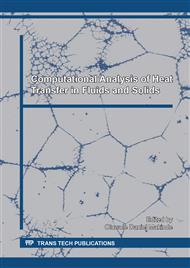[1]
M.D. Mhlongo, R.J. Moitsheki, Some exact solutions of nonlinear fin problem for steady heat transfer in longitudinal fin with different profiles, Advances in Mathematical Physics, vol. 2014, Article ID 947160, 16 pages, (2014).
DOI: 10.1155/2014/947160
Google Scholar
[2]
H.S. Kang, D.C. Look Jr., Two-dimensional trapezoidal fins analysis, Computational Mechanics, 19(3): 247-250, (1997).
DOI: 10.1007/s004660050173
Google Scholar
[3]
A.D. Kraus, A. Aziz, J. Welty, Extended surface heat transfer, John Wiley and Sons, (2002).
Google Scholar
[4]
A. Moradi, H. Ahmadikia, Analytical solution for different profiles of fin with temperaturedependent thermal conductivity, Mathematical Problems in Engineering, vol. 2010, Article ID 568263, 15 pages, (2011).
DOI: 10.1155/2010/568263
Google Scholar
[5]
F. Khani, M.A. Raji, H.H. Nejad, Analytical solutions and efficiency of the nonlinear fin problem with temperature-dependent thermal conductivity and heat transfer coefficient, Communications in Nonlinear Science and Numerical Simulation, 14(8): 3327-3338, (2009).
DOI: 10.1016/j.cnsns.2009.01.012
Google Scholar
[6]
P.L. Ndlovu, R.J. Moitsheki, Application of the two-dimensional differential transform method to heat conduction problem for heat transfer in longitudinal rectangular and convex parabolic fins, Communications in Nonlinear Science and Numerical Simulation 18(10): 2689-2698, (2013).
DOI: 10.1016/j.cnsns.2013.02.019
Google Scholar
[7]
R.J. Moitsheki, C. Harley, Steady thermal analysis of two-dimensional cylindrical pin fin with a non-constant base temperature, Mathematical Problems in Engineering, vol. 2011, Article ID 132457, 17 pages. (2011).
DOI: 10.1155/2011/132457
Google Scholar
[8]
R.J. Moitsheki, A. Rowjee, Steady heat transfer through a two-dimensional rectangular straight fin, Mathematical Problems in Engineering, vol. 2011, Article ID 826819, 13 pages, (2011).
DOI: 10.1155/2011/826819
Google Scholar
[9]
B.T.F. Chung, J.R. Iyer, Optimal design of longitudinal rectangular fins and cylindrical spines with variable heat transfer coefficient, Heat Transfer Engineering, 14(1): 31-42, (1993).
DOI: 10.1080/01457639308939792
Google Scholar
[10]
S.M. Ali, A.H. Bokhari, F.D. Zaman, A.H. Kara, Invariance, conservation laws and exact solutions of nonlinear cylindrical pin fin equation, Z. Naturfirsch, 69n: 195-198, (2013).
DOI: 10.5560/zna.2014-0008
Google Scholar
[11]
S.M. Ali, A.H. Bokhari, F.D. Zaman, A Lie symmetry classification of a nonlinear fin equation in cylindrical coordinates, Abstract and Applied Analysis, Vol 2014, Article ID 527410, 10 pages, (2014).
DOI: 10.1155/2014/527410
Google Scholar
[12]
S. Yadav, K.M. Pandey, A comparative thermal analysis of pin fins for improved heat transfer in forced convection, Materials Today: Proceedings, 5: 1711-1717, (2018).
DOI: 10.1016/j.matpr.2017.11.268
Google Scholar
[13]
J. K. Zhou, Differential transform method and its applications for electric circuits, Huazhong University Press, (1986).
Google Scholar
[14]
A. Kurnaz, G. Oturanç, M.E. Kiris, n-Dimensional differential transformation method for solving PDEs, International Journal of Computer Mathematics, 82(3): 369-380, (2005).
DOI: 10.1080/0020716042000301725
Google Scholar
[15]
M. Bakhshi, M. Asghari-Larimi, M. Asghari-Larimi, Three-dimensional differential transform method for solving nonlinear three-dimensional Volterra integral equations, The Journal of Mathematics and Computer Science, 2: 246-256, (2012).
DOI: 10.22436/jmcs.04.02.14
Google Scholar
[16]
K. Tabatabaei, E. Celik, R. Tabatabaei, The differential transform method for solving heat-like and wave-like equations with variable coefficients, Turkish Journal of Physics, 36(1): 87-98, (2012).
DOI: 10.3906/fiz-1102-6
Google Scholar
[17]
R.J Moitsheki, T. Hayat, M.Y. Malik, Some exact solutions of the fin problem with power law temperature-dependent thermal conductivity, Nonlinear Analysis: Real world Applications, 11(5): 3287-3294, (2010).
DOI: 10.1016/j.nonrwa.2009.11.021
Google Scholar
[18]
P.L. Ndlovu, R.J. Moitsheki, Analytical solutions for steady heat transfer in longitudinal fins with temperature-dependent properties, Mathematical Problems in Engineering, vol.2013, Article ID 273052, 14 pages. (2013).
DOI: 10.1155/2013/273052
Google Scholar
[19]
A. Aziz, O.D. Makinde: Entropy generation minimization design of a two-dimensional orthotropic convection pin fin, International Journal of Exergy, 7 (5), 579-592, (2010).
DOI: 10.1504/ijex.2010.034930
Google Scholar
[20]
O.D. Makinde, A. Aziz: Analysis of entropy generation and thermal stability in a long hollow cylinder. Heat and Mass Transfer, Vol. 47, 1407-1415, (2011).
DOI: 10.1007/s00231-011-0807-7
Google Scholar
[21]
L.C.G. Rogers, D. Talay, Numercial methods in finance, Cambridge University Press, Cambridge, (1997).
Google Scholar
[22]
R.L. Burden, J.D. Faires, Numerical analysis, Brooks/Cole, Grove, 7th ed., (2001).
Google Scholar
[23]
J.J.E. Cartwright, O. Piro, The dynamics of Runge-Kutta methods. Int. J. Bifurcation Chaos, 2, 427-449, (1992).
DOI: 10.1142/s0218127492000641
Google Scholar


